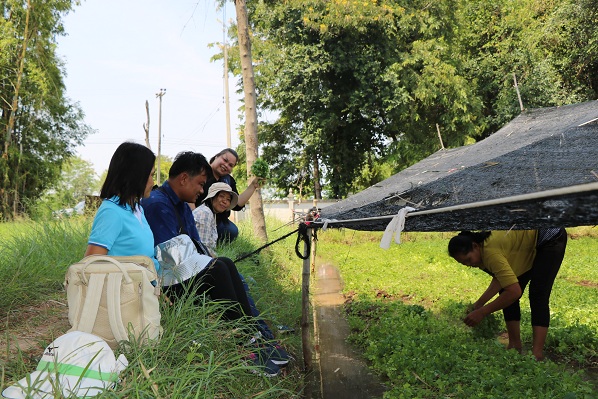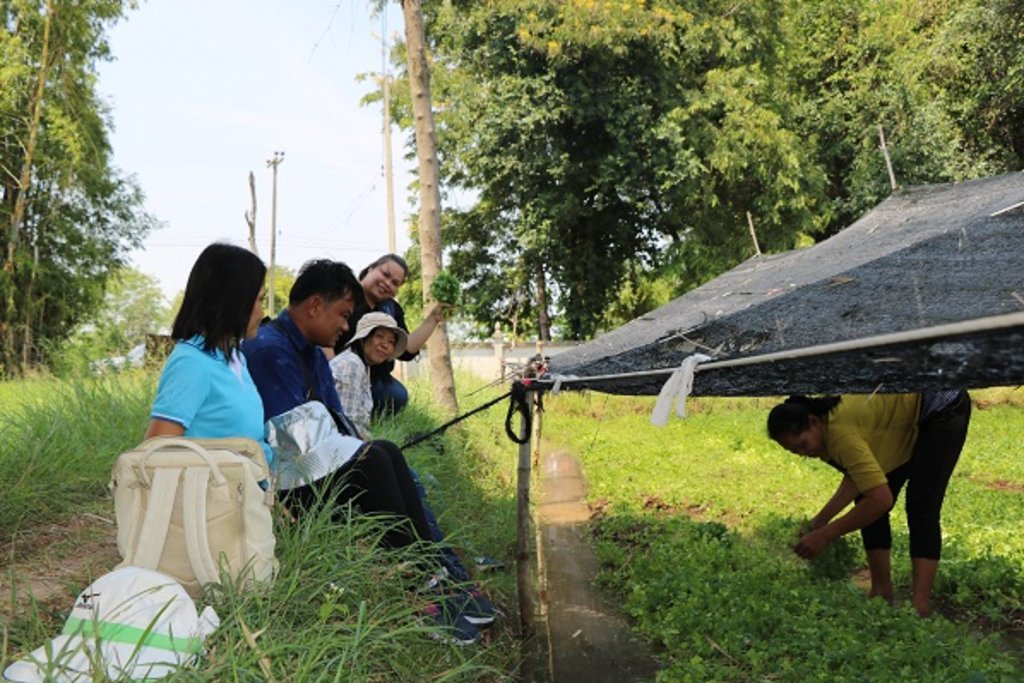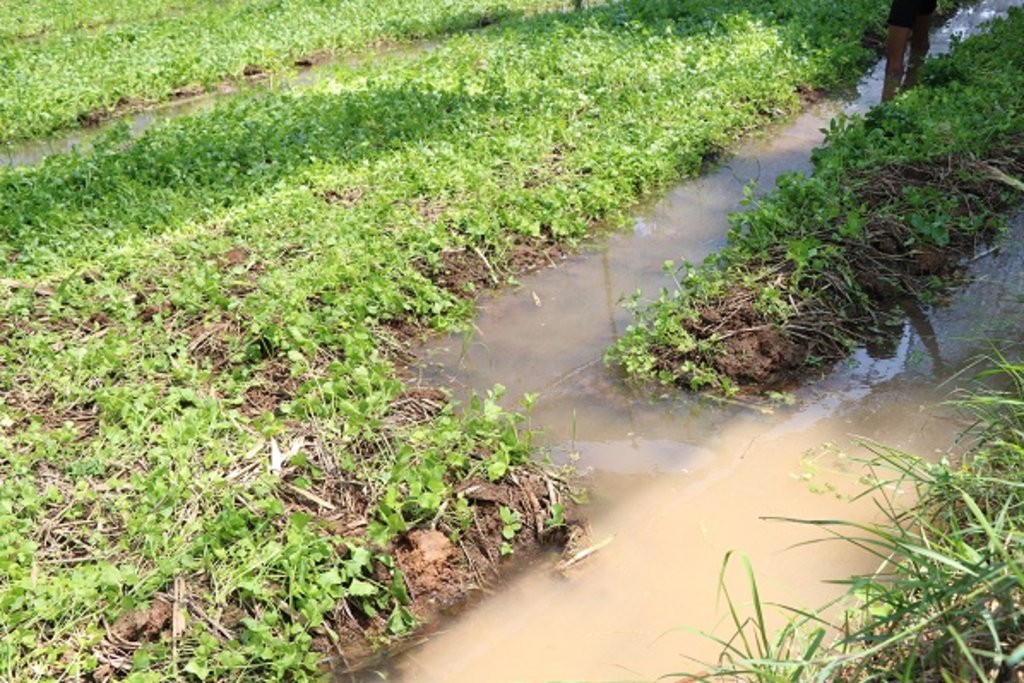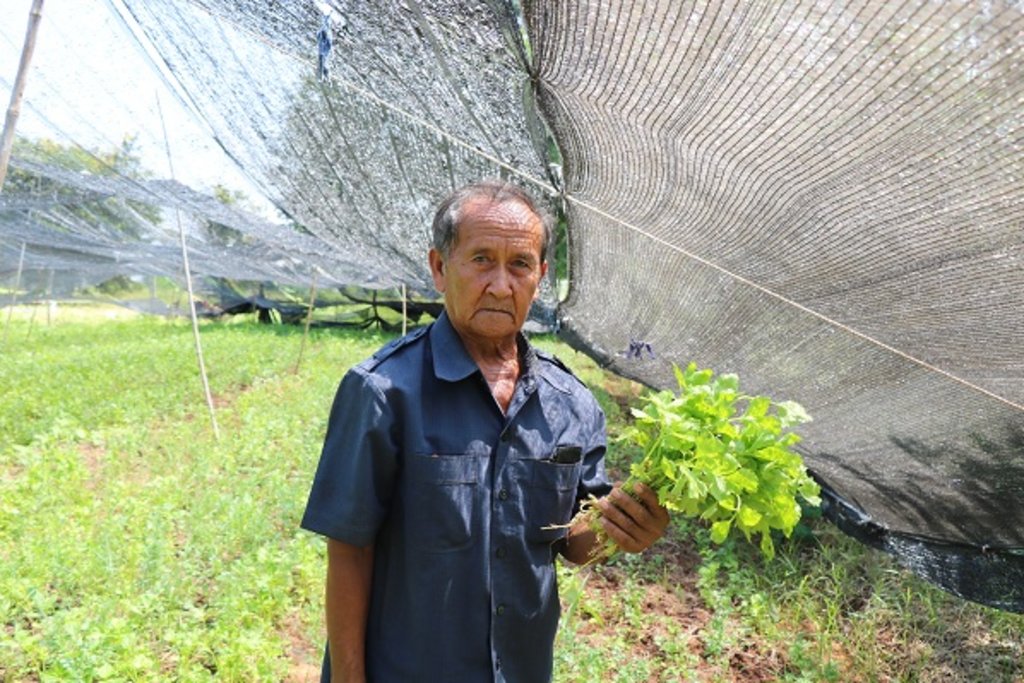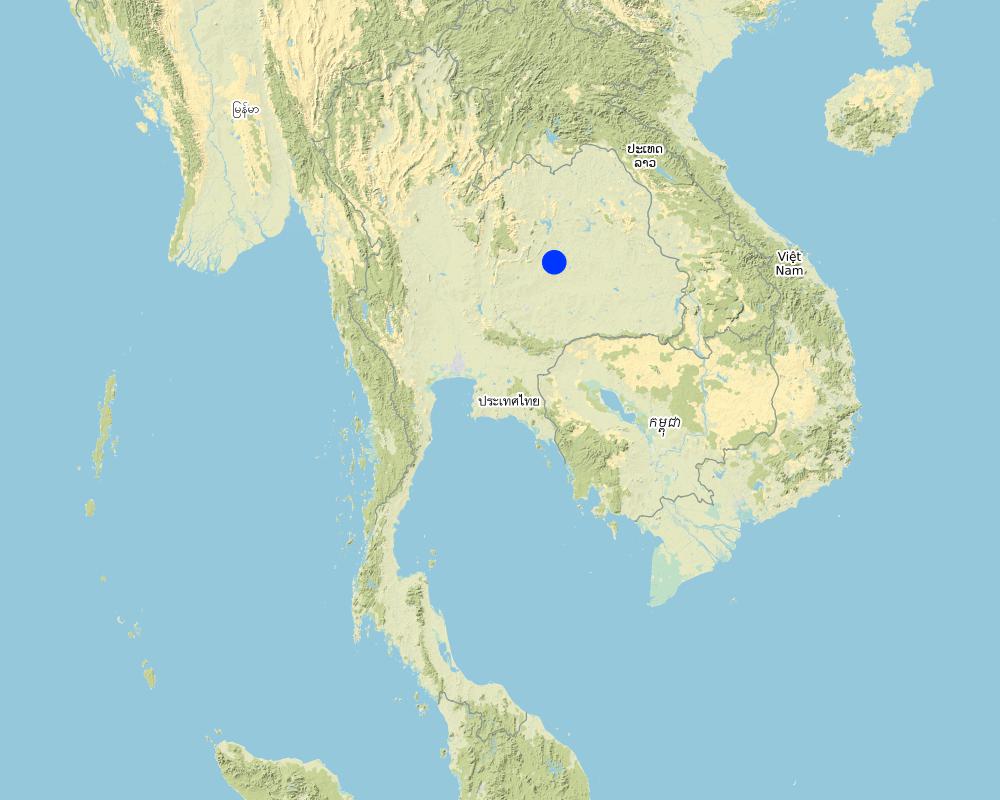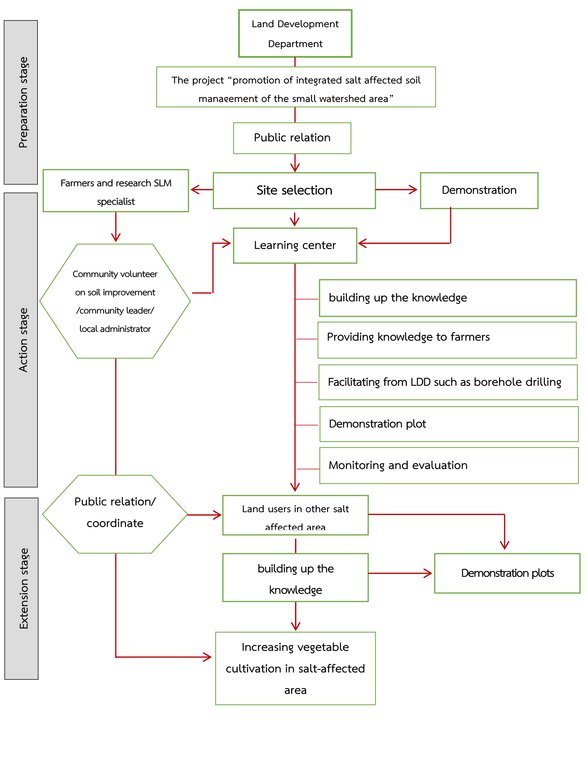Pumping groundwater for vegetable irrigation to prevent salination [Tailandia]
- Creación:
- Actualización:
- Compilador: supranee sritumboon
- Editor: –
- Revisores: Rima Mekdaschi Studer, Pitayakon Limtong, William Critchley
approaches_4298 - Tailandia
Visualizar secciones
Expandir todo Colapsar todos1. Información general
1.2 Detalles de contacto de las personas de referencia e instituciones involucradas en la evaluación y la documentación del Enfoque
Persona(s) de referencia clave/s
Somked Boonmee
Tailandia
Especialista MST:
Sihaban Pranee
pranee782@gmail.com
Land Development Department Regional Office 5
Tailandia
Especialista MST:
Sritumboon Supranee
ssritumboon@yahoo.com
Land Development Department Regional Office 5
Tailandia
Especialista MST:
Jakkarach Usa
usa_kl@hotmail.com
Land Development Department Regional Office 5
Tailandia
Especialista MST:
Rophandung Weera
weerop@hotmail.com
Land Development Department Regional Office 5
Tailandia
Especialista MST:
Phothinam Pornpana
laosuwan18@hotmail.com
Land Development Department Regional Office 5
Tailandia
Especialista MST:
National Consultant:
Arunin Somsri
ssarunin@gmail.com
Land Development Department
Tailandia
Nombre del proyecto que facilitó la documentación/ evaluación del Enfoque (si fuera relevante)
Decision Support for Mainstreaming and Scaling out Sustainable Land Management (GEF-FAO / DS-SLM)Nombre del proyecto que facilitó la documentación/ evaluación del Enfoque (si fuera relevante)
Book project: where people and their land are safer - A Compendium of Good Practices in Disaster Risk Reduction (DRR) (where people and their land are safer)Nombre del proyecto que facilitó la documentación/ evaluación del Enfoque (si fuera relevante)
Book project: where the land is greener - Case Studies and Analysis of Soil and Water Conservation Initiatives Worldwide (where the land is greener)Nombre de la(s) institución(es) que facilitaron la documentación/ evaluación del Enfoque si fuera relevante)
Land Development Department LDD (Land Development Department LDD) - Tailandia1.3 Condiciones referidas al uso de datos documentados mediante WOCAT
El compilador y la/s persona(s) de referencia claves aceptan las condiciones acerca del uso de los datos documentados mediante WOCAT :
Sí
2. Descripción del Enfoque MST
2.1 Breve descripción del Enfoque
The approach is to develop a simple groundwater pumping model for irrigation, on the basis of cooperation and knowledge sharing between government agencies and farmers, that addresses the risk and prevention of off-site salination.
2.2 Descripción detallada del Enfoque MST
Descripción detallada del Enfoque MST:
The objective of groundwater pumping for irrigation is to lower the groundwater level in the recharge zone which in turn decreases soil salinity lower down in the discharge area. The extension and promotion of the approach has been done through the learning and training center. The goal is better understanding and public awareness of preventive measure against salinity, through the use of salt-tolerant crops, combined with mechanical measures of accessing groundwater for irrigation. This has been achieved in close cooperation among researchers, SLM specialists, local administration, and community volunteers on soil improvement. A group of farmers started this activity in 1996 under the Land Development Department (LDD)’s Project on Promotion of Integrated Salt-Affected Soil Management of Small Watershed Areas. The approach aims at scaling-out the model to farmers in the recharge areas with the objectives of sharing benefits that are to (a) persuade other land users to change their land use from rice which is a high water-use crop to low water-use crops such as vegetables, (b) prevent further off-site salination, (c) increase land users’ income, and (d) provide knowledge about integrated salinity management. Researchers and SLM specialists work closely with farmers in monitoring and evaluating the recharge area to prevent extensive salination in the discharge zone - as well as the use of groundwater for irrigation. This plan has been formulated to stimulate further promotion and extension to other areas with a similar environment, through training and public relations. The four stages were: first, the expert and agriculturalist of the LDD’s Regional Office 5 (LDDRO5) cooperated with the volunteer soil doctor and farmers in the community to design and plan the project; second, the officers of LDDRO5 set up a forum for exchange of knowledge and experiences between farmers who have been successful in producing vegetables through using shallow groundwater for agriculture, and are not affected by a salinity. Thirdly, the officers of LDDRO5 collaborated with the government office in the district to train farmers who had an interest in vegetable production. Fourthly, LDDRO5 created incentives for farmers to change areas that are not suitable for planting paddy rice to grow vegetables by supporting shallow groundwater well through pumping with solar energy. The stakeholders include the LDD, SLM specialists and researchers, local administrators, and community volunteers on soil improvement and land users. Land users like the project activities because they receive higher incomes – partially because they do not lose land to digging ponds, but instead irrigate from these deep wells from which they can irrigate all year round. The LDD has supported borehole drilling wells – but farmers are not so happy when they have to wait for over a year to get LDD’s borehole drilling due to budget limitations.
2.3 Fotos del Enfoque
Comentarios generales sobre las fotos:
Vegetable cultivation was developed based on farmer experience.
2.4 Videos del Enfoque
Fecha:
02/10/2018
Lugar:
Ban Kaonoi
Nombre del videógrafo:
Supranee Sritumboon
2.5 País/ región/ lugares donde el Enfoque fue aplicado
País:
Tailandia
Región/ Estado/ Provincia:
Khon Kaen
Especifique más el lugar :
Ban Kaonoi
Map
×2.6 Fechas de inicio y conclusión del Enfoque
Indique año del inicio:
2007
Si no se conoce el año preciso, indique la fecha aproximada en la que se inició el Enfoque:
10-50 años atrás
2.7 Tipo de Enfoque
- proyecto/ basado en un programa
2.8 Propósitos/ objetivos principales del Enfoque
The objectives of the approach are to persuade land users in the recharge zone to change their land use to low-water use such as vegetable cultivation, to prevent further off-site salination, to increase land users’ income and provide knowledge of integrated salinity management.
2.9 Condiciones que facilitan o impiden la implementación de la/s Tecnología/s aplicadas bajo el Enfoque
normas y valores sociales/ culturales/ religiosos
- facilitan
Farmers' community
disponibilidad/ acceso a recursos y servicios financieros
- facilitan
Farmers get higher income from vegetables.
colaboración/ coordinación de actores
- facilitan
Researchers, SLM specialists and farmers are working together to implement the project.
conocimiento de MST, acceso a apoyo técnico
- facilitan
Provide knowledge of integrated salinity management to farmers.
mercados (para comprar insumos, vender productos) y precios
- facilitan
Farmers can produce plants according to market demand.
3. Participación y roles de las partes interesadas involucradas
3.1 Partes interesadas involucradas en el Enfoque y sus roles
- usuarios locales de tierras/ comunidades locales
Farmers
Vegetable cultivation
- especialistas MST/consejeros agrícolas
Government officers
Support knowledge and technology
- gobierno local
Subdistrict Administration Organization
Support information
- community volunteer on soil
Community volunteers on soil and successful farmers
Share knowledge and experience
Si varias partes interesadas estuvieron involucradas, indique la agencia principal:
Land Development Department Regional Office 5
3.2 Involucramiento de los usuarios locales de tierras/ comunidades locales en las distintas fases del Enfoque
| Involucramiento de los usuarios locales de tierras/ comunidades locales | Especifique quién se involucró y describa las actividades | |
|---|---|---|
| iniciación/ motivación | interactivo | Farmers had developed knowledge and technology by themselves |
| planificación | auto-movilización | Cultivation planning by farmers |
| implementación | interactivo | Farmers had implemented by themselves and were supported by the government |
| monitoreo y evaluación | interactivo | The government officers are monitoring and evaluating after the project was implemented |
3.3 Flujograma (si estuviera disponible)
3.4 La toma de decisiones en la selección de Tecnología(s) MST
Especifique quién decidió la selección de las Tecnología/ Tecnologías a implementarse:
- solamente usuarios de tierras (autoiniciativa)
Especifique las bases que sustentaron la toma de decisiones:
- la experiencia personal y opiniones (no documentadas)
4. Apoyo técnico, fortalecimiento institucional y gestión del conocimiento
4.1 Construcción de capacidades / capacitación
¿Se proporcionó la capacitación a usuarios de tierras/ otras partes interesadas?
Sí
Especifique quién fue capacitado:
- usuarios de tierras
Forma de capacitación:
- de agricultor a agricultor
Temas avanzados:
Promotion of integrated salt-affected soil management of the small watershed area.
Comentarios:
The topic covered vegetable production and salt-affected soil management.
4.2 Servicio de asesoría
¿Los usuarios de tierras tienen acceso a un servicio de asesoría?
No
4.3 Fortalecimiento institucional (desarrollo institucional)
¿Se establecieron o fortalecieron instituciones mediante el Enfoque?
- sí, mucho
Especifique el nivel o los niveles en los que se fortalecieron o establecieron las instituciones:
- local
Describa la institución, roles y responsabilidades, miembros, etc.
The learning and transferring center of land development technology was set up in the community to be used as a training facility, meeting, discussion, and sharing knowledge among farmers and officials.
Especifique el tipo de apoyo:
- construcción de capacidades/ entrenamiento
4.4 Monitoreo y evaluación
¿El monitoreo y la evaluación forman parte del Enfoque?
Sí
Comentarios:
Government officers, community volunteers on soil improvement and farmers.
Si respondió que sí, ¿la documentación se utilizará para monitoreo y evaluación?
Sí
4.5 Investigación
¿La investigación formó parte del Enfoque?
No
5. Financiamiento y apoyo material externo
5.1 Presupuesto anual para el componente MST del Enfoque
Si no se conoce el presupuesto anual preciso, indique el rango:
- 10,000-100,000
5.2 Apoyo financiero/material proporcionado a los usuarios de tierras
¿Los usuarios de tierras recibieron financiamiento/ apoyo material para implementar la Tecnología/ Tecnologías? :
No
5.3 Subsidios para insumos específicos (incluyendo mano de obra)
- equipo
| Especifique qué insumos se subsidiaron | En qué grado | Especifique los subsidios |
|---|---|---|
| herramientas | parcialmente financiado | Land Development Department Regional Office 5 supported water pump using solar energy. |
Si la mano de obra de usuarios de tierras fue un insumo sustancial, ¿fue:
- pagado en efectivo?
5.4 Crédito
¿Se proporcionó crédito bajo el Enfoque para actividades MST?
No
5.5 Otros incentivos o instrumentos
¿Se usaron otros incentivos o instrumentos para promover la implementación de Tecnologías MST?
No
6. Análisis de impacto y comentarios de conclusión
6.1 Impactos del Enfoque
¿El Enfoque empoderó a los usuarios locales de tierras, mejoró el involucramiento de las partes interesadas?
- No
- Sí, un poco
- Sí, moderadamente
- Sí, mucho
Cooperation between the government and farmers.
¿El Enfoque ayudó a los usuarios de tierras a implementar y mantener Tecnologías MST?
- No
- Sí, un poco
- Sí, moderadamente
- Sí, mucho
Farmers have a better understanding of the technology and willing to maintain it due to the good result.
¿El Enfoque mejoró el conocimiento y capacidades de los usuarios para implementar MST?
- No
- Sí, un poco
- Sí, moderadamente
- Sí, mucho
Farmers have adopted the technology to suit their own area.
¿El Enfoque mejoró el conocimiento y capacidades de otras partes interesadas?
- No
- Sí, un poco
- Sí, moderadamente
- Sí, mucho
The approach presented the efficient technology to develop salination for the stakeholders.
¿El Enfoque resultó en mejor seguridad alimentaria/ mejoró la nutrición?
- No
- Sí, un poco
- Sí, moderadamente
- Sí, mucho
Different types of vegetables leads to better food security.
¿El Enfoque mejoró el acceso a los mercados?
- No
- Sí, un poco
- Sí, moderadamente
- Sí, mucho
Higher productivity draws merchants into the project area.
¿El Enfoque llevó a oportunidades de empleo, ingresos?
- No
- Sí, un poco
- Sí, moderadamente
- Sí, mucho
The higher productivity and the wider area used for such technology cause more labour demand resulting in higher employment of people in the area.
6.2 Motivación principal del usuario de la tierra para implementar MST
- producción incrementada
Increase variety of product in the area
- reducción de la degradación de la tierra
Decrease salt distribution in soil
6.3 Sostenibilidad de las actividades del Enfoque
¿Pueden los usuarios de tierras sostener lo que se implementó mediante el Enfoque (sin apoyo externo)?
- sí
Si respondió que sí, describa cómo:
Farmers have a better understanding of off-site salination and they can develop the technology by themselves.
6.4 Fortalezas/ ventajas del Enfoque
| Fuerzas/ ventajas/ oportunidades desde la perspectiva del usuario de la tierra |
|---|
| Farmers get higher income from vegetable cultivation. |
| Land users have water to use for agriculture all year round. |
| Fuerzas/ ventajas/ oportunidades desde la perspectiva del compilador o de otra persona de referencia clave |
|---|
| Increase the varieties of agricultural products. |
| Lower the groundwater level and control the salinity that might spread toward the discharge area. |
6.5 Debilidades/ desventajas del Enfoque y formas de sobreponerse a ellos
| Debilidades/ desventajas/ riesgos desde la perspectiva del usuario de la tierra | ¿Cómo sobreponerse a ellas? |
|---|---|
| Farmers wait for more than one year to get help from LDD for borehole drilling due to limited budget. | Increase more government budget or farmers have to invest by themselves. |
| Debilidades/ desventajas/ riesgos desde la perspectiva del compilador o de otra persona de referencia clave | ¿Cómo sobreponerse a ellas? |
|---|---|
| High initial implementation cost if the farmers do not receive government support. | Farmers have to search for funds to invest by themselves. |
7. Referencias y vínculos
7.1 Métodos/ fuentes de información
- visitas de campo, encuestas de campo
Visit two land user's fields
- entrevistas con usuarios de tierras
Interview with one farmer
- entrevistas con especialistas/ expertos en MST
A Land Development Department officer
7.2 Referencias a publicaciones disponibles
Título, autor, año, ISBN:
Land Development Department
¿Dónde se halla disponible? ¿Costo?
http://www.ldd.go.th/
7.3 Vínculos a la información relevante disponible en línea
Título/ descripción:
where the land is greener - Case Studies and Analysis of Soil and Water Conservation Initiatives Worldwide
URL:
https://www.wocat.net/library/media/27/
Título/ descripción:
where people and their land are safer - A Compendium of Good Practices in Disaster Risk Reduction (DRR) (where people and their land are safer) URL:
URL:
https://www.wocat.net/en/projects-and-countries/projects/drr
Vínculos y módulos
Expandir todo Colapsar todosVínculos
No hay vínculos
Módulos
No se hallaron módulos


